parking brake CHEVROLET CAVALIER 1993 1.G Owner's Manual
[x] Cancel search | Manufacturer: CHEVROLET, Model Year: 1993, Model line: CAVALIER, Model: CHEVROLET CAVALIER 1993 1.GPages: 308, PDF Size: 15.62 MB
Page 187 of 308
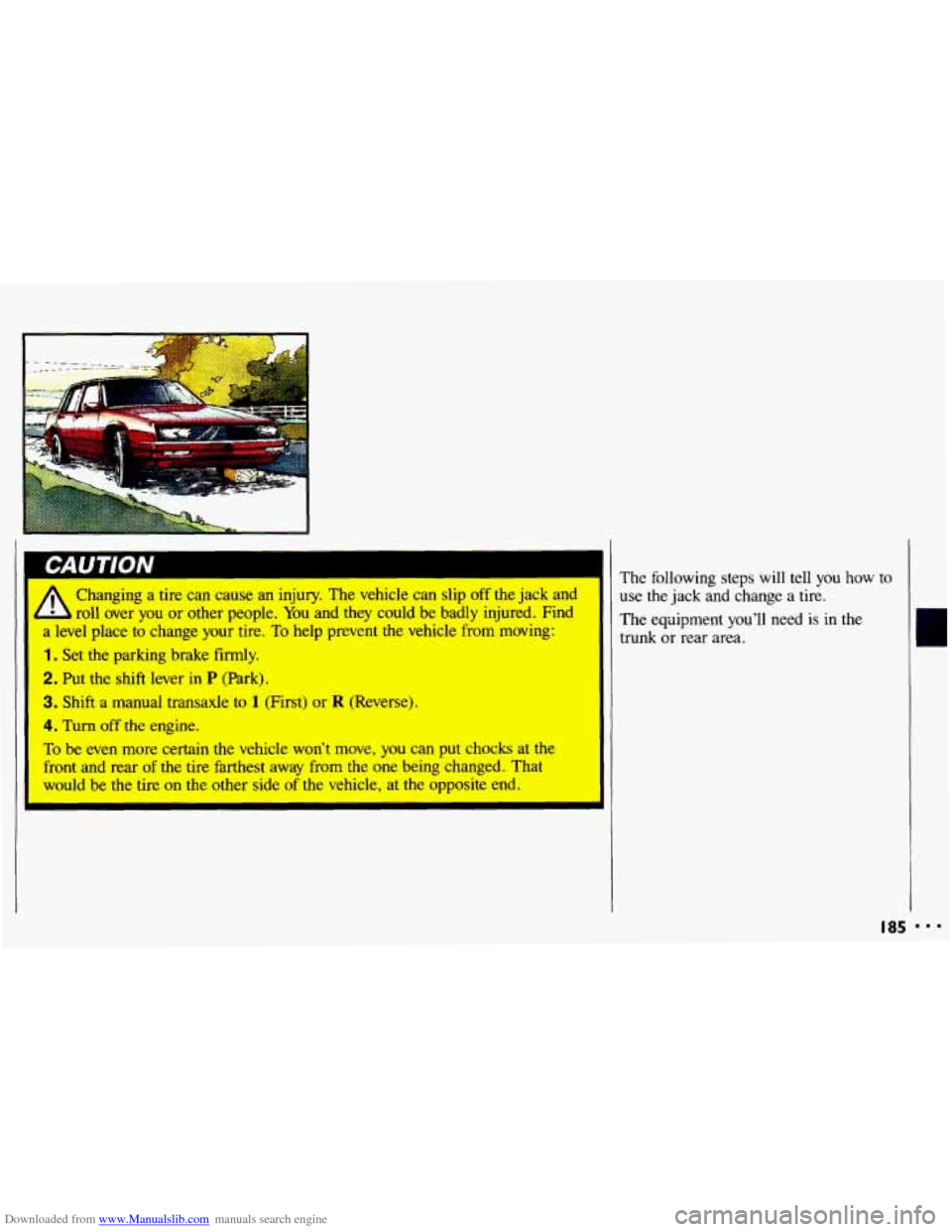
Downloaded from www.Manualslib.com manuals search engine 1
I
Changing a tire can cause an injury. The vehicle can slip off the jack and
roll over you or other people.
You and they could be badly injured. Find
a level place to change your tire.
To help prevent the vehicle from moving:
1. Set the parking brake firmly.
2. Put the shift lever in P (Park).
3. Shift a manual transaxle to 1 (First) or R (Reverse).
I 4. Turn off the engine.
To be even more certain the vehicle won’t move, you can put chocks at the
front and rear of the tire farthest away from the one being changed. That
would be the tire on the other side of the vehicle, at the opposite end. The
following steps will tell you how to
use the jack and change a tire.
The eqclipment you’ll need is in the
trunk or rear area.
I85
Page 214 of 308
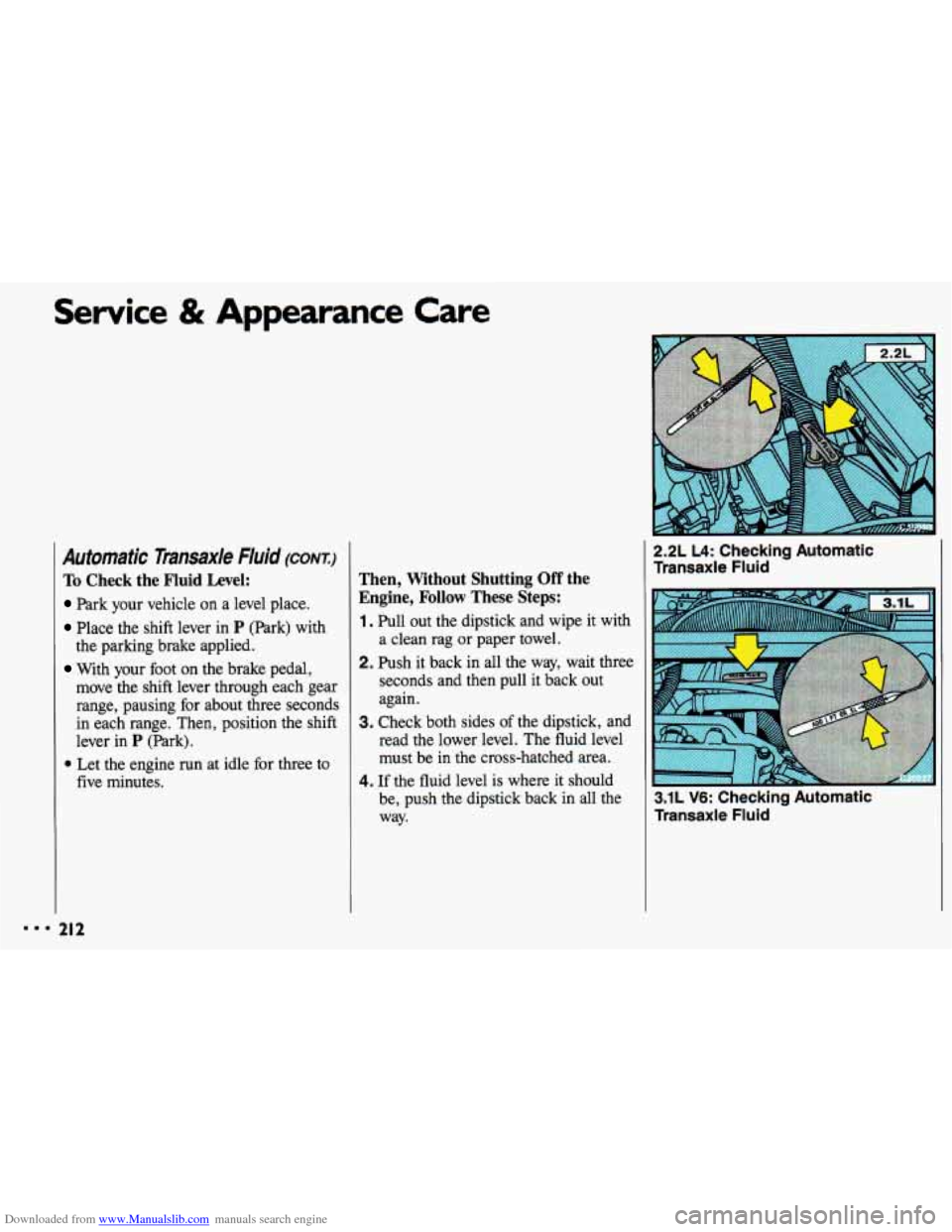
Downloaded from www.Manualslib.com manuals search engine Service & Appearance Care
Automatic Transaxle Fluid (CONT.)
To Check the Fluid Level:
Park your vehicle on a level place.
Place the shift lever in P (Park) with
With your foot on the brake pedal,
the
parking brake applied.
move the shift lever through each gear
range, pausing for about three seconds
in each range. Then, position the shift
lever in
P (Park).
Then, Without Shutting Off the
Engine,
Follow These Steps:
1. Pull out the dipstick and wipe it with
a clean rag or paper towel.
2. Push it back in all the way, wait three
seconds and then pull it back out
again.
3. Check both sides of the dipstick, and
read the lower level. The fluid level
must be in the cross-hatched area.
4. If the fluid level is where it should
be, push the dipstick back in all the
way.
2.2L L4: Checking Automatic
Transaxle Fluid
3.1L V6: Checking Automatic
Transaxle Fluid
Page 270 of 308
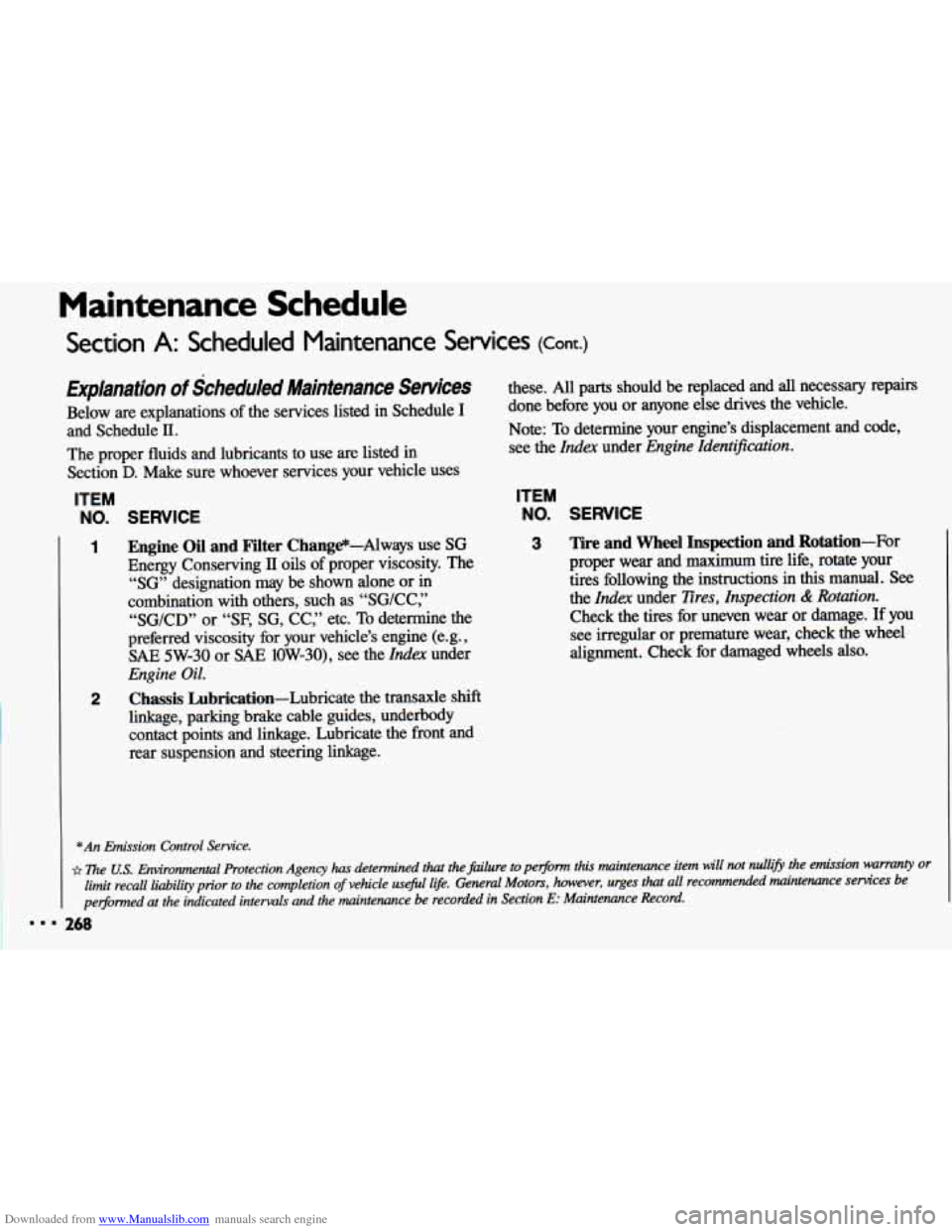
Downloaded from www.Manualslib.com manuals search engine Maintenance Schedule
Section A: Scheduled Maintenance Services (cont.)
Explanation of Scheduled Maintenance Services
Below are explanations of the services listed in Schedule I
and Schedule II.
The proper fluids and lubricants to use are listed in
Section
D. Make sure whoever services your vehicle uses
ITEM
NO. SERVICE
1
2 Engine Oil and Filter Change-Always use SG
Energy Conserving
11 oils of proper viscosity. The
“SG’ designation may be shown alone or in
combination with others, such as “SG/CC,”
“SG/CD” or “SF,
SG, CC,” etc. To determine the
preferred viscosity
for your vehicle’s engine (e.g.,
SAE 5W-30 or SAE 10W-30), see the Index under
Engine Oil.
Chassis Lubrication-Lubricate the transaxle shift
linkage, parking brake cable guides, underbody
contact points and linkage. Lubricate the front and
rear suspension and steering linkage.
Emission Control
Service.
these. All parts should be replaced and all necessary repairs
done before you or anyone else drives the vehicle.
Note: To determine your engine’s displacement and code,
see the Index under Engine Identification.
ITEM
NO.
3
SERVICE
Tire and Wheel Inspection and Rotation-For
proper wear and maximum tire life, rotate your
tires following the instructions
in this manual. See
the Index under Eres, Inspection & Rotation.
Check the tires for uneven wear or damage. If you
see irregular or premature wear, check the wheel
alignment. Check for damaged wheels also.
Page 274 of 308
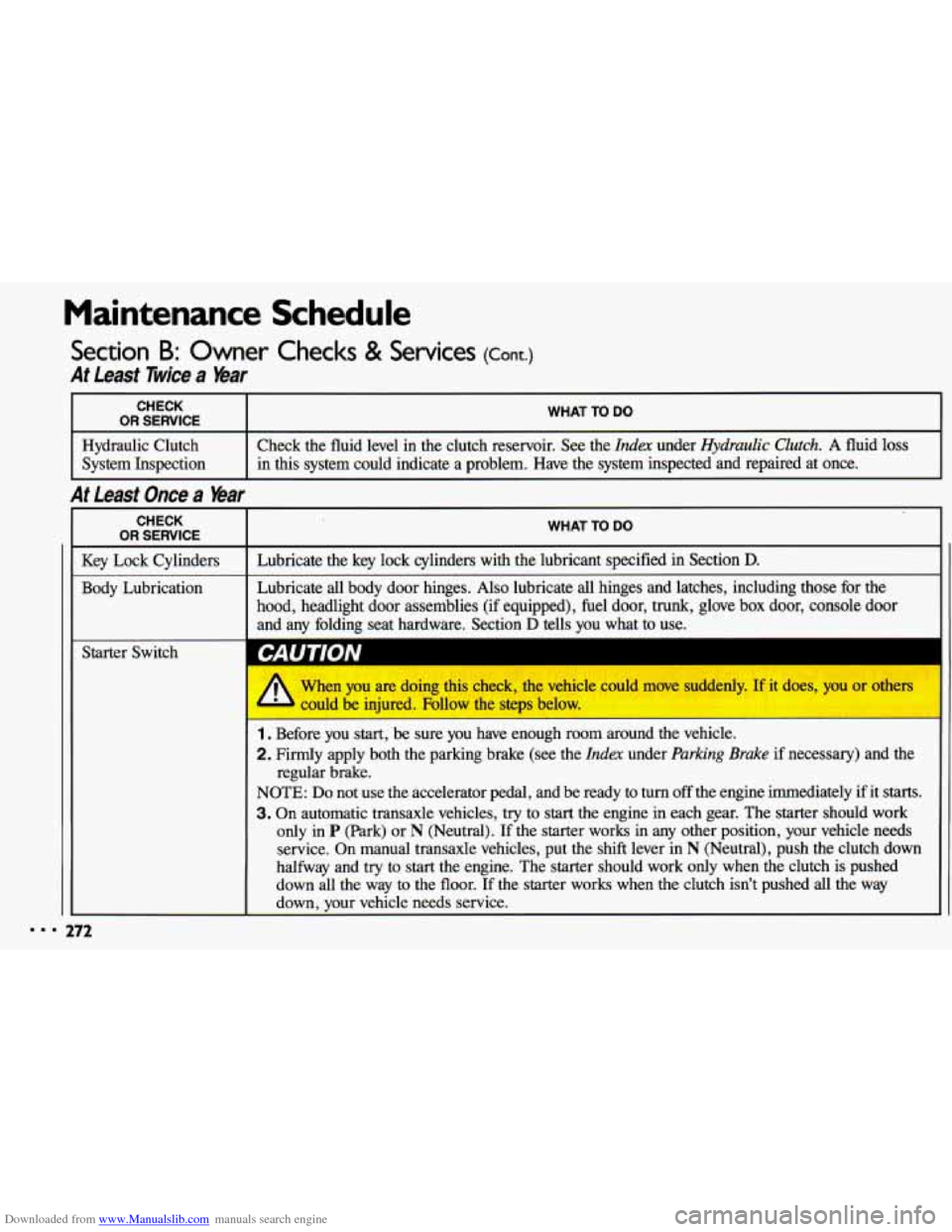
Downloaded from www.Manualslib.com manuals search engine Maintenance Schedule
Section B: Owner Checks & Services (Cont.)
At Least Twice a Year
... L
CHECK
I OR SERVICE I WHAT TO DO
Hydraulic Clutch
in this system could indicate a problem. Have the system inspected and repaired at once. System Inspection
Check
the fluid level in the clutch reservoir. See the Index under Hydraulic Clutch. A fluid loss
At Least Once a Year
CHECK
I OR SERVICE I WHAT TO DO
I
Key Lock Cylinders I Lubricate the key lock cylinders with the lubricant specified in Section D.
Body Lubrication Lubricate all body
door hinges. Also lubricate all hinges and latches, including those \
for the
hood, headlight door assemblies (if equipped), fuel door, trunk, glove box door, console door
and any folding seat hardware. Section
D tells you what to use.
L
272
I CAUTION
1. Before you start, be sure you have enough room around the vehicle.
2. Firmly apply both the parking brake (see the Index under Parking Brake if necessary) and the
NOTE:
Do not use the accelerator pedal, and be ready to turn off the engine immediately if it starts.
3. On automatic transaxle vehicles, try to start the engine in each gear. The starter should work
only in P (Park) or N (Neutral). If the starter works in any other position, your vehicle needs
service. On manual transaxle vehicles, put the shift lever in
N (Neutral), push the clutch down
halfway and
try to start the engine. The starter should work only when the clutch is pushed
down all the way to the floor. If the starter works when the clutch isn’t pushed all the way
down, your vehicle needs service.
regular brake.
I
Page 275 of 308
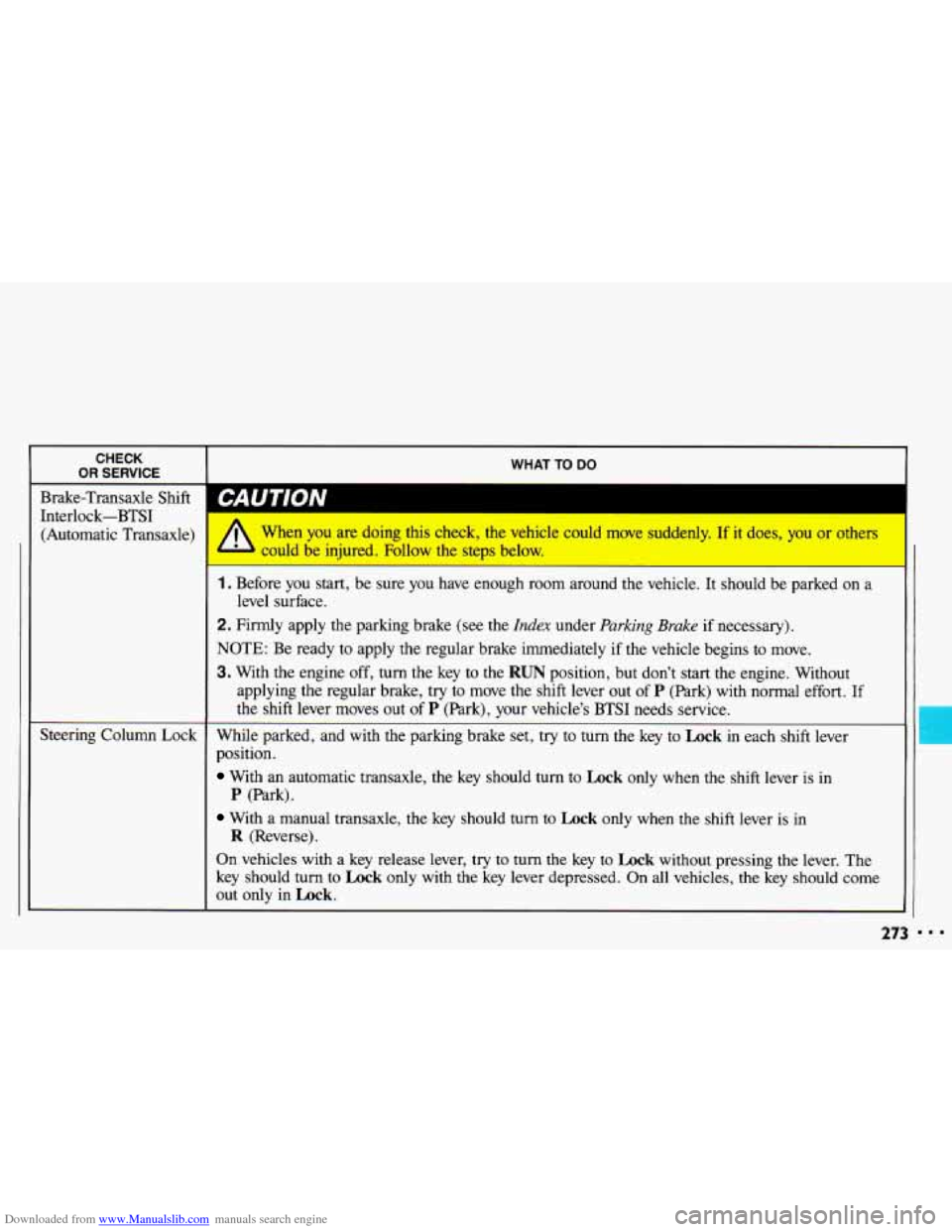
Downloaded from www.Manualslib.com manuals search engine CHECK
OR SERVICE WHAT TO DO
Interlock-BTSI (Automatic Transaxle
Steering Column Lock When
you are doing this check, the vehicle could move suddenly. If
it does, you or others
could be injured. Follow the steps below.
I
1. Before you start, be sure you have enough room around the vehicle. It should be parked on h
2. Firmly apply the parking brake (see the Ida under Parking Brake if necessary).
NOTE: Be ready to apply the regular brake immediately if the vehicle begins to move.
level surface.
3. With
the engine off, turn the key to the RUN position, but don’t start the engine. Without
applying the regular brake, try to move the shift lever
out of P (Park) with normal effort. If
the shift lever moves
out of P (Park), your vehicle’s BTSI needs service.
While parked, and with the parking brake set, try to turn the key
to Luck in each shift lever
position.
With an automatic transaxle, the key should turn to Lock only when the shift lever is in
P (Park).
With a manual transaxle, the key should turn to Lock only when the shift lever is in
R (Reverse).
On vehicles with a key release lever, try to turn the key to Lock without pressing the lever. The
key should
turn to Lock only with the key lever depressed. On all vehicles, the key should come
out only in
Lock.
273
Page 276 of 308
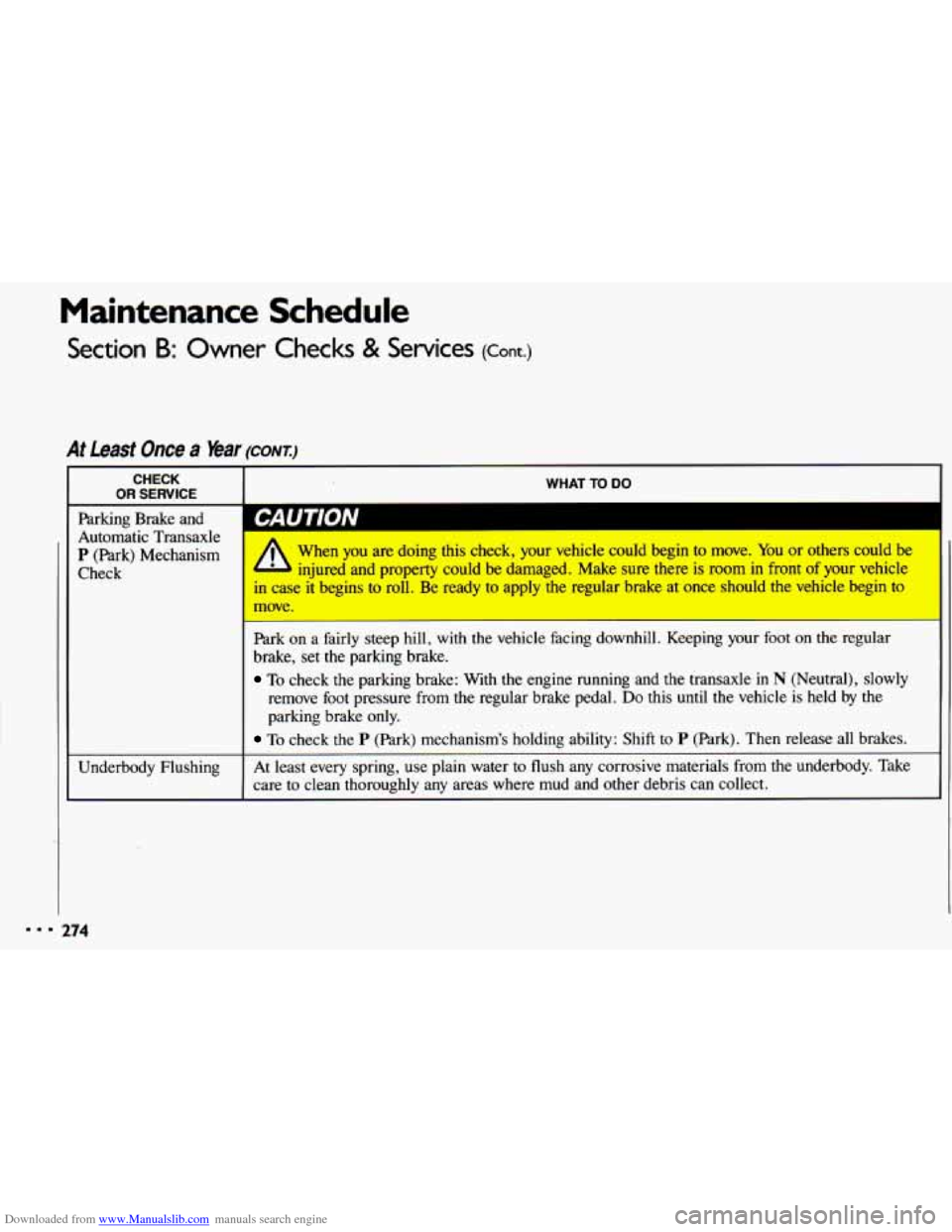
Downloaded from www.Manualslib.com manuals search engine Maintenance Schedule
Section B: Owner Checks & Services (Cont.)
At Least Once a Year (CONT:)
CHECK
OR SERVICE WHAT TO DO ~~
Parking Brake and
Automatic
Transaxle
P (Park) Mechanism When you are doing this check, your vehicle could begin to move. You or others could be I
Check A injured and property could be damaged. Make sure there is room in front of your vehicle
in case it begins to roll. Be ready to ~ ~ )ly the -gular brake at onc - Thould the vehicle begin to
Park on a fairly steep
hill, with the vehicle facing downhill. Keeping your foot on the regular
brake, set the parking brake.
To check the parking brake: With the engine running and the transaxle in N (Neutral), slowly
remove
foot pressure from the regular brake pedal. Do this until the vehicle is held by the
parking brake only.
To check the P (Park) mechanism’s holding ability: Shift to P (Park). Then release all brakes.
Underbody Flushing At least every spring, use plain water to flush any corrosive materials from the unde\
rbody. Take
I care to clean thoroughly any areas where mud and other debris can collect.
274
Page 277 of 308
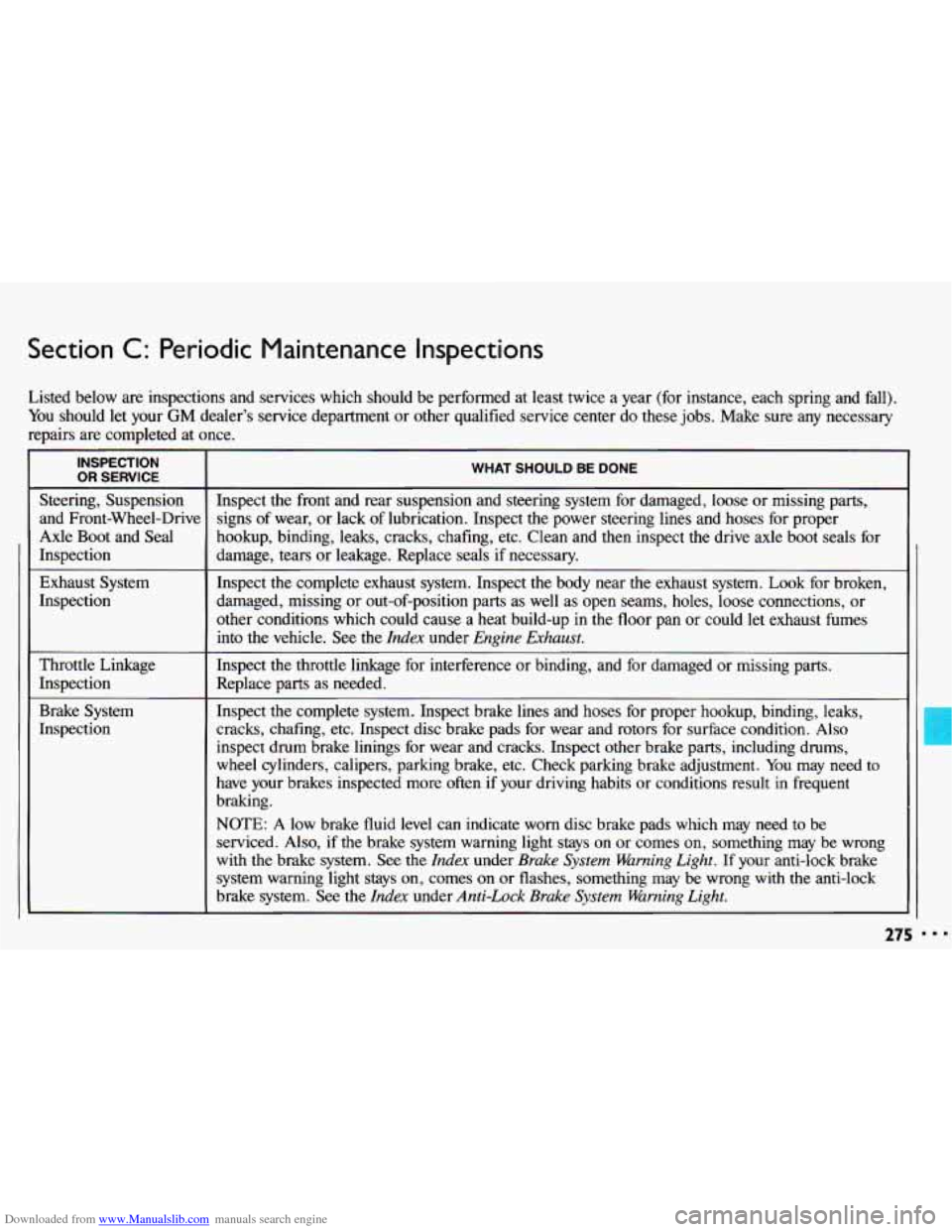
Downloaded from www.Manualslib.com manuals search engine Section C: Periodic Maintenance Inspections
Listed below are inspections and services which should be performed at least twice a year (for instance, each spring and fall).
You should let your GM dealer’s service department or other qualified service center do these jobs. Make sure any necessary
repairs are completed at once.
INSPECTION
I OR SERVICE
Steering, Suspension
and Front-Wheel-Drive
Axle Boot and Seal
1 Inspection
Exhaust System
Inspection
Throttle Linkage
Inspection
WHAT SHOULD BE DONE
Inspect the front and rear suspension and steering system for \
damaged, loose or missing parts,
signs of wear, or lack of lubrication. Inspect the power steering lines and hoses for proper
hookup, binding, leaks, cracks, chafing, etc. Clean and then in\
spect the drive axle boot seals for
damage, tears or leakage. Replace seals
if necessary.
Inspect the complete exhaust system. Inspect the body near
the exhaust system. Look for broken,
damaged, missing or out-of-position parts as well as open seams, holes, loose connections, or
other conditions which could cause a heat build-up in the floor pan or could let exhaust fumes
into the vehicle. See the
Index under Engine Exhaust.
Inspect the throttle linkage for interference or binding, and for damaged or missing parts.
Replace parts
as needed.
Inspect the complete system. Inspect brake lines and hoses for \
proper hookup, binding, leaks,
cracks, chafing, etc. Inspect disc brake pads for wear and rotors for \
surface condition. Also
inspect drum brake linings for wear and cracks. Inspect other brake parts, including drums,
wheel cylinders, calipers, parking brake, etc. Check parking brake adjustment. You may need to
have your brakes inspected more often
if your driving habits or conditions result in frequent
braking.
NOTE: A low brake fluid level can indicate worn disc brake pads which \
may need to be
serviced. Also,
if the brake system warning light stays on or comes on, something may be wrong
with the brake system. See the
Index under Brake System Warning Light. If your anti-lock brake
system warning light stays on, comes on or flashes, something may be wrong with the anti-lock
brake system. See the
Index under Anti-Lock Brake System Warning Light.
275 . .
Page 278 of 308
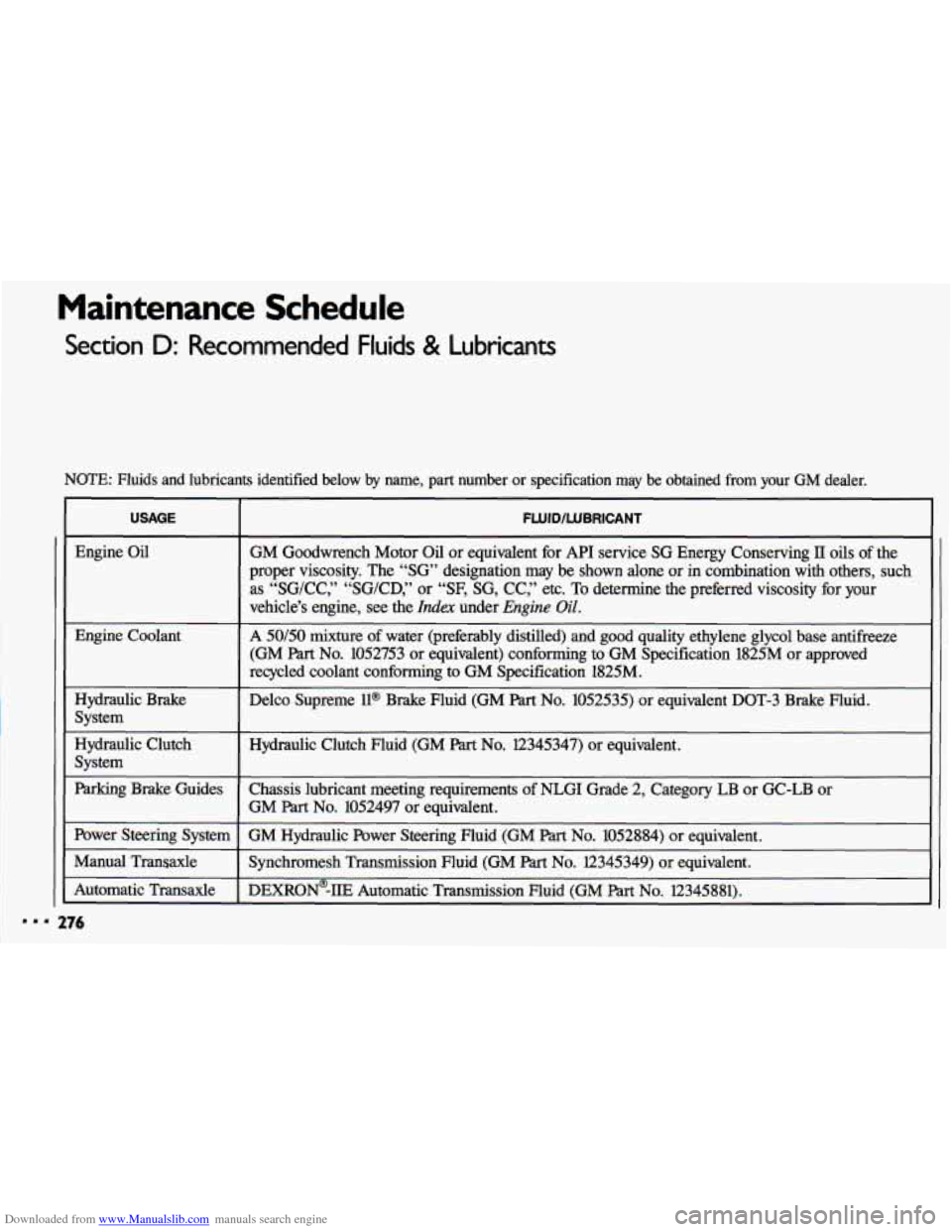
Downloaded from www.Manualslib.com manuals search engine Maintenance Schedule
Section D: Recommended Fluids & Lubricants
NOTE: Fluids and lubricants identified below by name, part number or specification may be obtained from your GM dealer.
USAGE
Engine Oil
Engine Coolant
Hydraulic Brake System
Hydraulic Clutch System
Parking Brake Guides
Power Steering System
Manual Transaxle
~~
Automatic Transaxle
FWID/WBRICANT
GM Goodwrench Motor Oil or equivalent for API service SG Energy Conserving II oils of the
proper viscosity. The “SG” designation may be shown alone or in combination with others, such
as “SG/CC,” “SG/CD,” or “SF, SG, CC,” etc. To determine the preferred viscosity for your
vehicle’s engine, see the
Index under Engine Oil.
A 50/50 mixture of water (preferably distilled) and good quality ethylene glycol \
base antifreeze
(GM
Part No. 1052753 or equivalent) conforming to GM Specification 1825M or approved
recycled coolant conforming to GM Specification 1825M.
Delco Supreme
ll@ Brake Fluid (GM Part No. 1052535) or equivalent DOT-3 Brake Fluid.
Hydraulic Clutch Fluid (GM
Part No. 12345347) or equivalent.
Chassis lubricant meeting requirements of NLGI Grade 2, Category LB or GC-LB
or
GM Part No. 1052497 or equivalent.
GM Hydraulic Power Steering Fluid (GM
Part No. 1052884) or equivalent.
Synchromesh Transmission Fluid (GM
Part No. 12345349) or equivalent.
DEXRON@-IIE Automatic Transmission Fluid (GM
Part No. 12345881).
276
Page 297 of 308
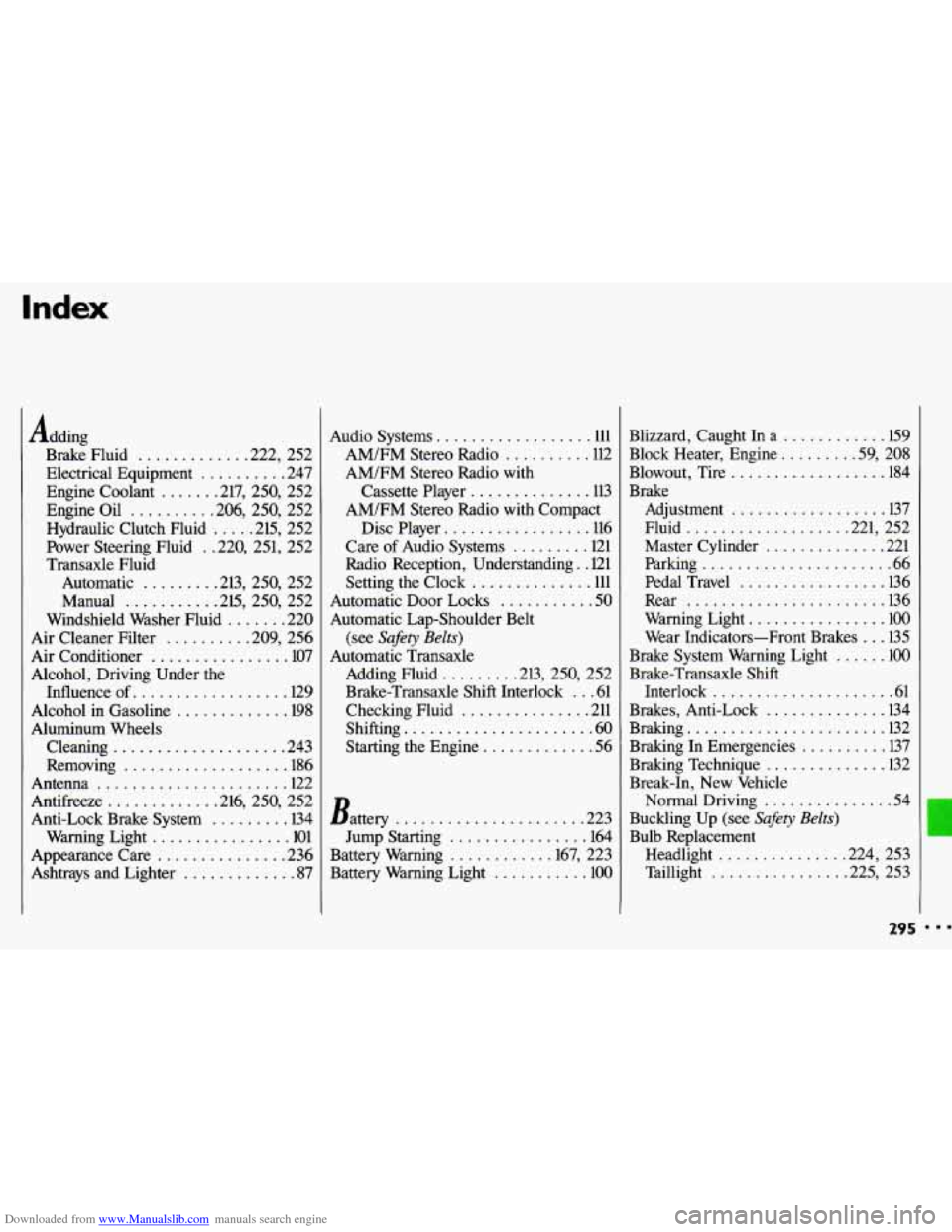
Downloaded from www.Manualslib.com manuals search engine Index
Adding Brake Fluid
............ .222. 252
Electrical Equipment
.......... 247
Engine Coolant
...... .217. 250. 252
Engine Oil
......... .206. 250. 252
Hydraulic Clutch Fluid
.... .2l5. 252
Power Steering Fluid
. .220. 251. 252
Transaxle Fluid Autornatic
........ .213. 250. 252
Manual
.......... .2l5. 250. 252
Windshield Washer Fluid
....... 220
Air Cleaner Filter
......... .209. 256
Air Conditioner
................ 107
Alcohol. Driving Under the Influence of
.................. 129
Alcohol in Gasoline
............. 198
Aluminum Wheels
Cleaning
.................... 243
Removing
................... 186
Antenna
...................... 122
Antifreeze
............ .216. 250. 252
Anti-Lock Brake System
......... 134
Warning Light
................ 101
Appearance Care
............... 236
Ashtrays and Lighter
............. 87
Audio Systems .................. 111
AM/FM Stereo Radio
.......... 112
AM/FM Stereo Radio with
Cassette Player
.............. 113
AM/FM Stereo Radio with Compact
Disc Player
................. 116
Care
of Audio Systems ......... 121
Radio Reception. Understanding
. . 121
Setting the Clock
.............. 111
Automatic Door Locks
........... 50
Automatic Lap-Shoulder Belt
(see
Safety Belts)
Automatic Transaxle
Adding Fluid
........ .213, 250, 252
Brake-Transaxle Shift Interlock
... 61
Checking Fluid
............... 211
Shifting
...................... 60
Starting the Engine ............. 56
Battery ...................... 223
Jump Starting
................ 164
Battery Warning
........... .167. 223
Battery Warning Light
........... 100 Blizzard. Caught
In a
............ 159
Block Heater. Engine
........ .59. 208
Blowout. Tire
.................. 184
Brake Adjustment
.................. 137
Fluid
.................. .221. 252
Master Cylinder
.............. 221
Parking
...................... 66
Pedal Travel
................. 136
Rear
....................... -136
Warning Light ................ 100
Wear Indicators-Front Brakes ... 135
Brake System Warning Light
...... 100
Brake-Transaxle Shift
Interlock
..................... 61
Brakes. Anti-Lock
.............. 134
Braking
....................... 132
Braking In Emergencies
.......... 137
Braking Technique
.............. 132
Break-In. New Vehicle
Normal Driving ............... 54
Buckling Up (see
Safety Belts)
Bulb Replacement
Headlight
.............. .224. 253
Taillight
............... .225. 253
295
Page 300 of 308
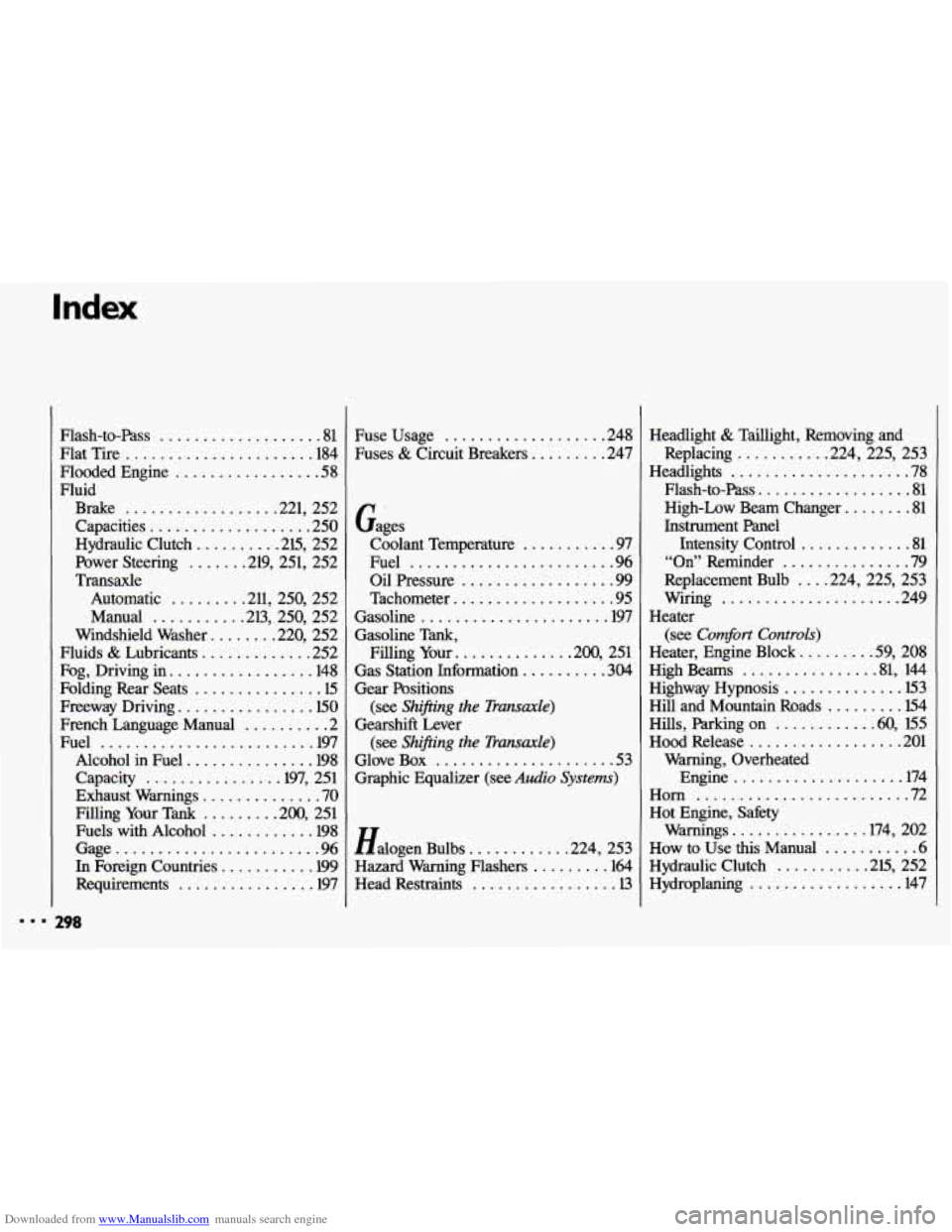
Downloaded from www.Manualslib.com manuals search engine Flash-to-Pass ................... 81
Flat Tire
...................... 184
Flooded Engine
................. 58
Fluid Brake
................. .221. 252
Capacities
................... 250
Hydraulic Clutch
......... .2l5. 252
Power Steering
...... .219. 251. 252
Transaxle
Automatic
........ .211. 250. 252
Manual
.......... .2l3. 250. 252
Windshield Washer
....... .220. 252
Fluids
& Lubricants ............. 252
Fog. Driving in
................. 148
Folding Rear Seats
............... l5
Freeway Driving ................ 150
French Language Manual .......... 2
Fuel
......................... 197
Alcohol in Fuel
............... 198
Capacity
............... .197. 251
Exhaust Warnings
.............. 70
Filling Your Tank
........ .200. 251
Fuels with Alcohol
............ 198
Gage
........................ 96
In Foreign Countries ........... 199
Requirements
................ 197
198
Fuse Usage ................... 248
Fuses
& Circuit Breakers ......... 247
Gaies Coolant Temperature
........... 97
Fuel
........................ 96
Oil Pressure
.................. 99
Tachometer
................... 95
Gasoline
...................... 197
Gasoline Tank. -Filling Your
............. .200. 251
Gas Station Information
.......... 304
Gear Positions
Gearshift Lever
Glove Box
.................... i., . 53
Graphic Equalizer (see
Audio Systems)
(see Shlfing the Transaxle)
(see Shifting the Transaxle)
Halogen Bulbs ........... .224. 253
Hazard Warning Flashers
........ -164
Head Restraints
................. 13
Headlight & Taillight. Removing and
Replacing
.......... .224. 225. 253
Headlights
..................... 78
Flash-to-Pass
.................. 81
High-Low Beam Changer
........ 81
Instrument Panel Intensity Control
............. 81
“On” Reminder
............... 79
Replacement Bulb
... .224. 225. 253
Wiring
..................... 249
(see
Comfort Controls)
Heater Heater. Engine Block
........ .59. 208
High Beams
............... .81. 144
Highway Hypnosis
.............. 153
Hill and Mountain Roads
......... 154
Hills. Parking on
........... .a. 155
Hood Release .................. 201
Engine
.................... 174
Horn
......................... 72
Hot Engine. Safety
Warnings
............... .174. 202
How to Use
this Manual ........... 6
Hydraulic Clutch .......... .2l5. 252
Hydroplaning
.................. 147
Warning. Overheated